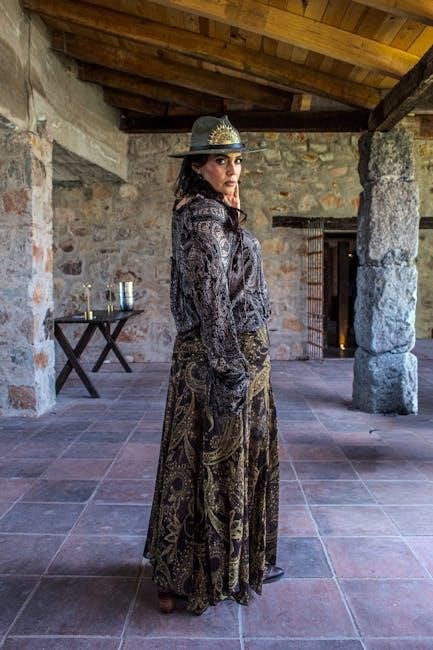The 1982 DC Style Guide established a unified visual identity for DC Comics, standardizing character designs, colors, and artistic approaches. It ensured consistency across Superman and other characters, becoming a cornerstone for brand recognition and creative coherence, vital in preserving DC’s visual legacy.
1.1 Historical Context and Purpose
In 1982, DC Comics addressed the need for a unified visual language to maintain consistency across its expanding universe. The Style Guide was created to standardize character depictions, ensuring iconic heroes like Superman, Batman, and Wonder Woman had cohesive designs. This initiative aimed to strengthen brand identity and provide clear guidelines for artists and licensees. By establishing detailed model sheets and color palettes, the guide ensured visual harmony across comics, merchandise, and media. Its purpose was to preserve the legacy of DC’s characters while adapting to the evolving demands of the industry and fandom.
1.2 The Importance of Visual Consistency
Visual consistency in the DC Style Guide ensures characters like Superman are instantly recognizable across all media. Uniform designs maintain brand integrity, reinforcing fan trust and emotional connection. Consistency simplifies collaboration for artists and licensees, ensuring accuracy in character portrayal. This harmony strengthens DC’s visual identity, making it easier for audiences to engage with the universe. By standardizing elements like costumes and expressions, the guide guarantees a cohesive look, essential for merchandise, comics, and adaptations. This consistency is vital for building a timeless and unified DC brand, ensuring characters remain iconic and unforgettable.
1.3 Superman’s Role in the Style Guide
Superman, as DC’s flagship character, plays a central role in the Style Guide. His iconic design serves as the benchmark for visual consistency, ensuring his recognizable appearance across all media. The guide meticulously details Superman’s costume, facial features, and poses, providing clear standards for artists and licensees; His timeless design influences the overall aesthetic of the DC Universe, making him a cornerstone of the guide’s success. By standardizing Superman’s image, the guide ensures his iconic status endures, maintaining fan recognition and emotional connection to the character.

Creation and Development of the 1982 DC Style Guide
The 1982 DC Style Guide was developed to standardize character designs, ensuring visual consistency across DC’s expanding universe. It featured detailed profiles, costume guidelines, and reference materials.
2.1 The Vision Behind the Guide
The 1982 DC Style Guide was conceived to unify the visual identity of DC characters, including Superman, across various media. Its primary goal was to ensure consistency in character designs, costumes, and expressions. This vision aimed to strengthen DC’s brand by providing clear visual standards for artists and licensors. By standardizing Superman’s iconic look, the guide helped maintain his recognizable and timeless appeal. It also sought to balance creative freedom with adherence to core design principles, ensuring the Man of Steel remained a symbol of hope and heroism. This approach laid the foundation for DC’s modern visual identity.
2.2 Key Contributors: Paul Levitz and José Luis García-López
The 1982 DC Style Guide was shaped by two pivotal figures: Paul Levitz and José Luis García-López. Paul Levitz, then a rising executive at DC, championed the project, ensuring its vision aligned with the company’s goals. José Luis García-López, a renowned artist, brought his meticulous craftsmanship to the guide, defining Superman’s timeless look. His detailed illustrations set the standard for character consistency. Together, they balanced artistic excellence with practical guidelines, creating a foundational resource for DC’s visual identity.
2.3 The Design Process and Challenges
The creation of the 1982 DC Style Guide involved a rigorous design process to ensure visual consistency. The team developed detailed model sheets for Superman and other characters, standardizing their appearances. Challenges included maintaining uniformity across artists and balancing classic elements with modern aesthetics. The process required extensive collaboration, with José Luis García-López refining designs while Paul Levitz oversaw alignment with DC’s broader goals. The guide’s success relied on precise guidelines, reference materials, and iterative feedback, ultimately setting a benchmark for future character design and branding efforts.

José Luis García-López’s Impact
José Luis García-López’s clean, dynamic art style became the cornerstone of DC’s visual identity, influencing Superman’s modern look and inspiring countless artists in the industry.

3.1 His Artistic Style and Influence
José Luis García-López’s artistic style brought clarity and dynamism to Superman’s visual identity. His bold lines and balanced compositions emphasized character details and energy. García-López’s work became the standard for consistency across DC’s Universe, ensuring Superman’s iconic status. His ability to blend classic ideals with modern aesthetics inspired countless artists. His influence extended beyond comics, shaping merchandise and adaptations. García-López’s style harmonized tradition and innovation, making him a pivotal figure in DC’s visual legacy. His contributions remain foundational, ensuring Superman’s timeless appeal in the DC Style Guide and beyond.
3.2 Model Sheets and Character Design
José Luis García-López’s model sheets were pivotal in establishing Superman’s consistent visual identity. These detailed templates outlined precise guidelines for poses, expressions, and costume details, ensuring uniformity across media. García-López’s meticulous approach was crucial for licensing, maintaining a recognizable appearance. His work influenced other artists, fostering coherence. The sheets became essential for the DC Style Guide, guiding artists and licensors. García-López’s contributions preserved Superman’s integrity, ensuring his iconic status endured.
3.3 Legacy in Modern DC Art
José Luis García-López’s work on the DC Style Guide continues to inspire modern artists, ensuring Superman’s timeless appeal. His model sheets remain a cornerstone for character design, maintaining consistency across comics, merchandise, and adaptations. García-López’s influence is evident in contemporary reinterpretations of Superman, blending classic elements with modern aesthetics. His contributions have cemented the Man of Steel’s iconic status, reinforcing DC’s visual identity. García-López’s legacy underscores the enduring importance of cohesive design in preserving beloved characters for future generations of fans and creators alike.

Superman’s Visual Identity
Superman’s iconic red-and-blue costume, yellow “S” shield, and flowing cape define his instantly recognizable visual identity. This design has been meticulously maintained across comics, films, and merchandise, ensuring consistency and reinforcing his status as a cultural icon.
4.1 Iconic Costume and Color Scheme
Superman’s costume is a masterclass in visual storytelling, with its red, blue, and yellow color scheme symbolizing truth, justice, and hope. The iconic “S” shield on his chest serves as a universal symbol of heroism. The cape, a hallmark of Superman’s identity, represents strength and authority. The DC Style Guide meticulously details these elements to ensure consistency across all media, reinforcing Superman’s recognizable image globally. The color scheme and design have remained largely unchanged, cementing Superman’s status as an enduring visual icon in popular culture.
4.2 Facial Expressions and Poses
Superman’s facial expressions and poses are carefully defined to reflect his heroic and compassionate nature. The DC Style Guide emphasizes expressions that convey confidence, determination, and approachability. Classic poses, such as the iconic “hero stance” with hands on hips, are showcased to highlight strength and authority. Model sheets provide reference for consistent depictions, ensuring Superman’s expressions align with his character traits. These guidelines help artists maintain a cohesive visual identity, reinforcing Superman’s role as a symbol of hope and heroism across all media.
4.4 The Evolution of Superman’s Design
Superman’s design has evolved subtly over the years, with the 1982 DC Style Guide playing a pivotal role in standardizing his appearance. The guide ensured consistency in his iconic red and blue suit, yellow “S” shield, and flowing cape. It also established proportions for his physique, making him appear strong yet agile. These guidelines helped maintain Superman’s recognizable and timeless visual identity, ensuring his design remained cohesive across various adaptations and reinterpretations while staying true to his original essence as a symbol of hope and heroism.

The 1982 Style Guide’s Content
The 1982 DC Style Guide provided detailed guidelines for Superman’s character design, including his iconic costume, facial expressions, and poses; It also included reference materials for artists to ensure visual consistency across all DC publications and merchandise, solidifying Superman’s status as a timeless and recognizable character in comic book history.
5.1 Detailed Character Profiles
The 1982 DC Style Guide included comprehensive profiles for Superman, outlining his appearance, posture, and expressions. It featured precise illustrations by José Luis García-López, ensuring consistency in depictions. The guide detailed Superman’s iconic costume, emphasizing the red and blue color scheme, the “S” shield, and cape dynamics. Facial expressions ranged from calm confidence to intense determination, while poses highlighted his heroic stature. These detailed guidelines helped artists maintain visual uniformity, reinforcing Superman’s recognizable identity across DC’s vast media spectrum and licensing partnerships. This section was crucial for standardizing Superman’s image, ensuring his iconic status endured.
5.2 Costume Guidelines and Regulations
The 1982 DC Style Guide established strict guidelines for Superman’s costume, ensuring consistency across all media. It specified the iconic red and blue color scheme, the “S” shield’s shape and placement, and the cape’s flowing design. The guide detailed proportions, such as the width of the belt and the style of boots, to maintain a cohesive look. These regulations ensured Superman’s costume remained instantly recognizable, aiding artists and licensees in accurate depictions. The guide emphasized color accuracy and design uniformity, preserving Superman’s iconic identity while allowing for subtle variations in modern interpretations.
5.3 Artistic Direction and Reference Materials
The 1982 DC Style Guide provided detailed artistic direction, ensuring uniformity in Superman’s depiction. It included model sheets, character profiles, and visual references to guide artists. José Luis García-López’s precise illustrations served as the foundation for these materials. The guide emphasized proper proportions, dynamic poses, and consistent facial expressions. Reference images covered various scenarios, from action sequences to calm moments, aiding in maintaining visual coherence. These resources were essential for licensees and creators, ensuring Superman’s image remained consistent across comics, merchandise, and other media, solidifying his iconic status.

The Reissue of the 1982 Style Guide
The 1982 DC Style Guide was reissued to preserve its historical significance and provide modern creators with foundational reference materials for Superman and other DC characters.
6;1 The Long-Awaited Reprint
The 1982 DC Style Guide’s reprint was met with immense excitement, fulfilling decades of demand from fans and collectors. Faithful to the original, it preserved the guide’s historical integrity while introducing it to a new generation. High-quality scans ensured the vibrant artwork and detailed character designs remained intact. The reprint also included additional content, such as archival materials and essays, offering deeper insights into its creation. This limited edition became a sought-after collectible, celebrating Superman’s enduring legacy and the guide’s influence on DC’s visual identity. It continues to inspire artists and solidify the guide’s importance in comic history.
6.2 Updates and Additions
The reissued DC Style Guide included new character profiles, expanding on Superman’s mythos and modern interpretations. Updated designs reflected contemporary storytelling while maintaining the classic aesthetic. Digital enhancements improved image quality without compromising the original artwork’s charm. Additional historical context and behind-the-scenes insights were added, offering fans a deeper understanding of the guide’s creation. These updates ensured the style guide remained relevant, bridging the gap between its 1982 roots and the demands of modern storytelling and character development.
6.3 Fan Reception and Significance
The reissued DC Style Guide was met with widespread enthusiasm from fans, who celebrated its return as a vital resource for Superman’s visual legacy. Collectors and artists praised the updated content and improved presentation, while newcomers appreciated its historical significance. The guide’s re-release underscored Superman’s enduring appeal and reinforced his status as an iconic character. Fans also highlighted its value as a nostalgic treasure, bridging generations of comic book enthusiasts. This reissue solidified the guide’s place as a cornerstone of DC’s visual identity and a testament to Superman’s timeless impact on popular culture.

Influence on DC Merchandise and Licensing
The DC Style Guide significantly influenced merchandise, ensuring consistent character designs across products. It became a key reference for license holders, maintaining Superman’s iconic look and DC’s brand identity.
7.1 Ensuring Consistency Across Products
The DC Style Guide played a pivotal role in maintaining visual consistency across Superman merchandise. By providing precise design standards, it ensured that Superman’s iconic look remained uniform in toys, apparel, and other products. This consistency reinforced his recognizable identity, making him a cohesive brand ambassador. Licensees relied on the guide to accurately portray Superman, ensuring his image aligned with DC’s vision. This uniformity not only protected the character’s integrity but also strengthened DC’s overall brand identity in the global market, solidifying Superman’s status as a cultural icon.
7.2 The Role of License Holders
License holders play a crucial role in upholding Superman’s brand integrity by adhering to the DC Style Guide. They are responsible for producing merchandise that faithfully represents the character’s iconic design. By following the guide, licensees ensure consistency across all products, maintaining Superman’s recognizable identity. This collaboration benefits both DC and license holders by preserving the character’s appeal and integrity. The consistent portrayal of Superman reinforces his status as a cultural icon, ensuring his enduring popularity in various markets and mediums.
7.3 Impact on DC’s Brand Identity
The DC Style Guide significantly strengthens DC’s brand identity by ensuring consistent and recognizable character designs, with Superman at the forefront. Uniform visual standards across comics, merchandise, and media reinforce DC’s reputation for quality and coherence. This consistency fosters fan trust and loyalty, solidifying DC’s position as a leader in the comic industry. The guide’s influence extends beyond Superman, shaping the visual language for other characters and overall storytelling, thereby enhancing DC’s global brand recognition and appeal while maintaining its iconic status in popular culture.

The Legacy of the DC Style Guide
The DC Style Guide’s legacy endures through Superman’s timeless design, safeguarding DC’s visual identity and inspiring future artists, ensuring the brand’s iconic status remains unshakable.
8.1 Timeless Character Designs
The DC Style Guide established timeless character designs, particularly for Superman, ensuring consistency across mediums. José Luis García-López’s detailed model sheets became the definitive reference, blending classic aesthetics with modern appeal. Superman’s iconic red and blue costume, along with his recognizable facial features, was standardized, ensuring fans worldwide could instantly identify the character. These designs not only unified DC’s visual identity but also influenced countless adaptations, from comics to film, cementing Superman’s status as a cultural icon. The guide’s emphasis on clarity and simplicity has kept these designs relevant, even as artistic styles evolve.
8.2 Inspiring Future Artists
José Luis García-López’s work in the DC Style Guide has become a cornerstone for aspiring artists, offering a masterclass in character design and consistency. His meticulous attention to detail and ability to capture Superman’s essence have inspired generations of illustrators. The guide’s model sheets and reference materials serve as a foundational tool, teaching artists how to maintain visual coherence while adapting characters for new stories and mediums. This resource has not only shaped comic book art but also influenced animation, film, and merchandise, ensuring Superman’s legacy continues to evolve while staying true to his iconic design.
8.3 Cultural Impact Beyond Comics
The DC Style Guide has significantly influenced popular culture, extending Superman’s reach beyond comics. Its standardized designs have shaped movie and TV portrayals, ensuring visual consistency. This uniformity has made Superman an instantly recognizable global icon, featured in films, TV shows, and merchandise. The guide’s impact is evident in DC’s broader brand identity, reinforcing Superman’s status as a cultural symbol across generations and media platforms.

Superman in the Modern DC Universe
Superman remains a cornerstone of the DC Universe, blending classic ideals with contemporary storytelling. His character evolves, balancing humanity with heroism, while staying true to his iconic legacy.
9.1 Adapting the Style Guide for New Media
The DC Style Guide has been adapted for modern media, ensuring Superman’s iconic design remains consistent across films, TV, video games, and digital comics. This process involves translating the original visual guidelines into new formats while maintaining the character’s recognizable features. Digital artists use reference materials from the 1982 guide to create 3D models and animations, preserving the essence of Superman’s classic look. This adaptation ensures visual coherence, making Superman’s identity timeless and universally recognizable, even as storytelling mediums evolve.
9.2 Superman’s Role in the DC Multiverse
Superman’s role in the DC Multiverse is defined by his consistent visual identity, as outlined in the Style Guide. Across various universes, Superman maintains recognizable core traits, ensuring fans can identify him instantly. The guide’s character profiles and design standards help unify his appearance, even as alternate versions emerge. Superman’s iconic status as a symbol of hope and justice remains intact, reinforcing his role as a cornerstone of the DC Multiverse. This consistency preserves his legacy while allowing creative exploration of his character in diverse storytelling contexts.
9.3 Balancing Tradition and Innovation
The DC Style Guide ensures Superman’s design honors his legacy while embracing modern creativity. By maintaining core visual elements, such as the iconic “S” shield and red-and-blue costume, the character remains instantly recognizable. At the same time, subtle updates, like streamlined lines or new materials, reflect contemporary aesthetics. This balance allows Superman to evolve without losing his timeless appeal. The guide’s flexibility supports innovation, enabling adaptations across media while preserving the essence of the character. This approach keeps Superman relevant in an ever-changing comic and multimedia landscape.
The DC Style Guide has cemented Superman’s visual identity, blending tradition with innovation to ensure his timeless appeal. Its influence remains vital for future adaptations.
10.1 The Enduring Importance of the Style Guide
The DC Style Guide remains a cornerstone of visual storytelling, ensuring Superman’s iconic design stays consistent and recognizable. Its detailed guidelines have shaped the character’s identity across media, from comics to merchandise. By standardizing visuals, it has maintained brand integrity and inspired countless adaptations. The guide’s adaptability has allowed it to evolve, keeping Superman relevant in modern storytelling while honoring his timeless appeal. Its influence extends beyond comics, impacting film, animation, and licensing, solidifying its role as a foundational resource for DC’s creative vision.
10.2 Superman’s Iconic Status
Superman’s enduring appeal lies in his timeless symbol of hope and heroism, cemented by the DC Style Guide. His iconic red and blue costume, paired with the “S” shield, is universally recognizable. The guide ensures this imagery remains consistent, reinforcing Superman’s status as a cultural icon. Beyond comics, his influence spans film, television, and merchandise, making him a global symbol of truth and justice. The Style Guide’s meticulous attention to detail has preserved Superman’s essence, allowing his legend to endure across generations and media platforms.
10.3 The Future of DC’s Visual Identity
The DC Style Guide’s influence will continue shaping the brand’s visual identity, blending tradition with innovation; As DC expands into digital media and global markets, the guide remains a cornerstone for consistency. Future updates may incorporate new character designs and technologies, ensuring timeless appeal. By balancing classic aesthetics with modern creativity, DC will maintain its status as a leader in visual storytelling. The guide’s legacy ensures that Superman and other iconic characters remain central to DC’s evolving visual landscape, inspiring future generations of artists and fans alike.
